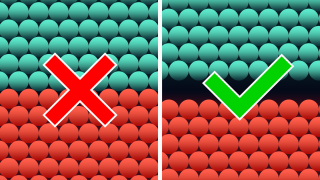You Can't Touch Anything
Published: August 9, 2022 at 10:19 PM (PT)
4:56
(8882 frames/30fps) Resolution:1920x1080
(FHD) Most Rewatched:0:45 to 0:54 Realtime Statistics...
30 Minutes...
Hour...
24 Hours...
Information Sources
https://education.jlab.org/qa/atomicstructure_11.html
Number of Atoms in the Human Bodyhttps://alexaanswers.amazon.com/question/6IzRZ9358VKz9iImkO4Rih/ref=cbqa_pqd_sim_q
Atom Factshttps://simple.wikipedia.org/wiki/Nuclear_physics
Electrons Orbit Like a Solar System (outdated)http://astronomy.nmsu.edu/tharriso/ast110/Ast105week07.html
Lithium Atomhttps://en.wikipedia.org/wiki/Lithium_atom
Words Made from the Periodic Tablehttps://sciencenotes.org/list-words-made-periodic-table-element-symbols
How the Periodic Table Workshttps://www.amnh.org/explore/ology/physics/how-to-read-the-periodic-table
Atom Structurehttp://chemed.chem.purdue.edu/genchem/topicreview/bp/ch6/atom_emrframe.html
Hydrogen Atomhttps://en.wikipedia.org/wiki/Hydrogen_atom
Oganesson Atomhttps://en.wikipedia.org/wiki/Oganesson
Isotopeshttp://www.chem.uiuc.edu/rogers/Text4/Tx42/tx42.html
Half Lifehttps://homework.study.com/explanation/when-is-an-isotope-considered-stable-a-the-isotope-does-not-emit-a-form-of-radiation-b-the-isotope-s-half-life-is-longer-than-the-average-human-life-c-the-isotope-emits-some-form-of-radiation.html
Size of Heliumhttps://en.wikipedia.org/wiki/Atomic_radii_of_the_elements_(data_page)
Everyone Can Fit in a Sugar Cubehttps://www.businessinsider.in/science/you-could-fit-the-entire-human-race-into-a-sugar-cube-and-13-other-facts-to-put-the-universe-into-perspective/slidelist/53831581.cms
Touching is Impossiblehttps://www.futurescienceleaders.com/blog/2020/02/touching-is-impossible
Graphic Sources
N/A
Desk Fan (Daniel Roberts)N/A
Light Bulb (kinggodarts)https://pixabay.com/vectors/bulb-light-electricity-energy-lamp-6602798
Yellow Car (Daniel Roberts)https://www.alamy.com/just-an-orange-car-image471694088.html
Man Silhouette (Daniel Roberts)N/A
Lithium Atom 01 (N/A)https://www.edumple.com/cbse-class-9/science/chapter-4structure-of-atom/notes
Lithium Atom 02 (Atomic Archive)https://atomicarchive.com/science/index.html
Lithium Atom 03 (Ben Radler)https://benradler.com/blog/2016/06/09/how-to-set-up-ctags-go-to-definition-in-atom-text-editor
Lithium Atom 04 (N/A)N/A
Atom 05 (Gorkhs)https://pixabay.com/illustrations/atom-logo-science-1472657
Lithium Atom 06 (Electrical4U)https://www.electrical4u.com/concept-of-atom
Lithium Atom 07 (AG Caesar)https://commons.wikimedia.org/wiki/File:Atom_Diagram.svg
Lithium Atom 08 (Caroline)https://iheartcraftythings.com/atom-drawing.html
Lithium Atom 09 (VectorMine)https://letstalkscience.ca/educational-resources/backgrounders/introduction-static-electricity
Lithium Atom 10 (EWT)https://energywavetheory.com/atoms
Lithium Atom 11 (PNGWing)https://www.pngwing.com/en/free-png-amnii
Periodic Table (Daniel Roberts)N/A
Audio Sources
N/A
To the Galaxy (Daniel Roberts)https://pixabay.com/music/ambient-to-the-galaxy-10734
Chart Ballad-with strings (Daniel Roberts)N/A
Pop2 (Daniel Roberts)N/A
Every physical object is made up of atoms.
You, as a physical object, are made up of
approximately 6.5 octillion atoms.
But believe it or not,
you're basically nothing.
At an atomic scale you'd be
completely invisible and because of that
you wouldn't be able to collide with anything.
You're probably really confused right now...
Anyway,
this is an atom.
All atoms consist of protons, neutrons, and electrons.
The protons and neutrons make up the nucleus
and the electrons orbit around the nucleus,
much like a solar system.
This particular atom is a lithium atom.
It's the one that you see everywhere.
It has 3 electrons, 3 protons, and 3 neutrons.
The amount of protons, neutrons, and electrons is
what determines what type of material the atom is.
This is the Periodic Table.
This is where you have all your Dynamite, Pancakes, and Taxes.
Each element has an atomic number which is
this number here at the top.
The atomic number refers to the number of protons and,
for all neutral atoms,
the number of electrons.
The element with the lowest atomic number,
or the fewest protons,
is hydrogen which is the simplest of all elements.
It has only 1 electron, 1 proton, and no neutrons.
The element with the highest atomic number is Oganesson
with approximately 118 protons, 118 electrons, and 184 neutrons.
However, each element has isotopes.
Isotopes are basically the family of the element.
So for example, hydrogen has has three "members" in it's family.
Protium, Deuterium, and Tritium.
The Protium isotope is what you saw earlier,
it has one proton and one electron.
It is stable and is the most common of the three isotopes
making up 99.985% of all naturally occurring hydrogen atoms.
Deuterium, on the other hand, has a neutron and proton but,
though it's stable, it only makes up about 0.0156% of
all naturally occurring hydrogen.
Tritium has two neutrons, and, unlike the other two isotopes,
is not stable with a half-life of less than 13 years.
Also, to be clear, a half-life is how long it takes for an atom to
turn into a different element or isotope.
So it's basically the lifetime of that specific isotope or element,
it's not exactly the lifetime of the atom in general.
Another thing to note about atoms
is that they are extremely small.
Which you probably knew.
You could fit over 50 million atoms in just one inch!
However, it's important to note that not all atoms are the same size.
Helium, the smallest and funniest atom,
is about 62 picometers in diameter,
while the largest atom, Caesium, is about 265 picometers in diameter.
So you could actually fit anywhere from 47 million
to 400 million atoms in an inch.
Atoms are mostly nothing.
Even though they're often displayed like this,
they're designed just like a solar system.
If you scaled each proton, neutron, and electron down to it's actual size
you wouldn't be able to see any of it!
This is why you'd be invisible at an atomic scale.
In fact, if you could remove all the empty space in the atoms
that make up every person on the planet,
you could fit everyone into a sugar cube!
This also raises an important question,
"If there's so much empty space,
what holds the atom together?"
The atom is held together by four forces,
electromagnetic force,
strong nuclear force,
weak nuclear force,
and gravity.
The electromagnetic force is what keeps the electrons
in orbit around the nucleus.
This is because the electron is negatively charged
while the protons are positively charged.
And the neutrons just sit there since they are neutral.
Probably why they're called neutrons.
Anyway, the strong nuclear force is what holds the
protons and neutrons together creating the nucleus.
The weak nuclear force controls how the atom decays.
And of course gravity just pulls everything together.
What is most surprising about all this is that since atoms are
mostly just empty space, held together by invisible forces,
it's not the atoms that collide but actually the invisible forces
around them.
Thus one surface never actually comes into contact with another.
They are always separated by a small space.
This is the exact reason why you can't touch anything.
It might look like you're touching something,
in fact it probably feels like you're touching something,
but you never actually come into contact with the surface.
All you're feeling is just the repelling forces,
not the actual atoms themselves.
And if you could remove the invisible forces you'd
be able to walk right through a wall like it wasn't even there,
because there's nothing to collide with.
The chance of two atoms hitting each other
would be very slim.
Of course if you changed your definition of touch...

